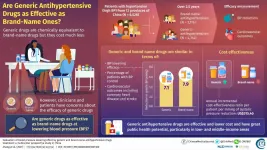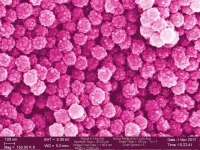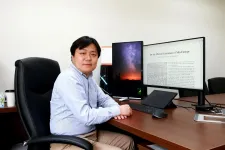(Press-News.org) Researchers at the U.S. Department of Energy's National Renewable Energy Laboratory (NREL) developed a breakthrough in energy-efficient phototransistors. Such devices could eventually help computers process visual information more like the human brain and be used as sensors in things like self-driving vehicles.
The structures rely on a new type of semiconductor--metal-halide perovskites--which have proven to be highly efficient at converting sunlight into electrical energy and shown tremendous promise in a range of other technologies.
"In general, these perovskite semiconductors are a really unique functional system with potential benefits for a number of different technologies," said Jeffrey Blackburn, a senior scientist at NREL and co-author of a new paper outlining the research. "NREL became interested in this material system for photovoltaics, but they have many properties that could be applied to whole different areas of science."
In this case, the researchers combined perovskite nanocrystals with a network of single-walled carbon nanotubes to create a material combination they thought might have interesting properties for photovoltaics or detectors. When they shined a laser at it, they found a surprising electrical response.
"What normally would happen is that, after absorbing the light, an electrical current would briefly flow for a short period of time," said Joseph Luther, a senior scientist and co-author. "But in this case, the current continued to flow and did not stop for several minutes even when the light was switched off."
Such behavior is referred to as "persistent photoconductivity" and is a form of "optical memory," where the light energy hitting a device can be stored in "memory" as an electrical current. The phenomenon can also mimic synapses in the brain that are used to store memories. Often, however, persistent photoconductivity requires low temperatures and/or high operating voltages, and the current spike would only last for small fractions of a second. In this new discovery, the persistent photoconductivity produces an electrical current at room temperature and flows current for more than an hour after the light is switched off. In addition, only low voltages and low light intensities were found to be needed, highlighting the low energy needed to store memory.
The research is spelled out in the paper, "Low-Energy Room-Temperature Optical Switching in Mixed-Dimensionality Nanoscale Perovskite Heterojunctions," which appears in the journal Science Advances. In addition to Blackburn and Luther, the paper was co-authored by Ji Hao, Young-Hoon Kim, Severin Habisreutinger, Steven Harvey, and Elisa Miller, all from NREL, and by scientists from the University of Wisconsin-Madison and the University of Toledo.
Other scientists have been working toward optical memory and neuromorphic computing, which emulates the way the human brain stores information. The brain uses a "neural network" of neurons that interact with many other neurons across synapses. This highly interconnected network is one of the primary reasons the brain can process information in such an energy-efficient way, so there is a big motivation for scientists to create artificial neural networks that mimic the functions of the brain.
The research provides previously lacking design principles that can be incorporated into optical memory and neuromorphic computing applications. Visual perception accounts for the vast majority of input the brain collects about the world, and these artificial synapses could be integrated into image recognition systems.
"There are many applications where sensor arrays can take in images and apply training and learning algorithms for artificial intelligence and machine-learning-type applications," Blackburn said. "As an example, such systems could potentially improve energy efficiency, performance, and reliability in applications such as self-driving vehicles."
The researchers tried three different types of perovskites--formamidinium lead bromide, cesium lead iodide, and cesium lead bromide--and found each was able to produce a persistent photoconductivity.
"What we made is only one of the simplest devices you could make from combining these two systems, and we demonstrated a simplistic memory-like operation," Blackburn said. "To build a neural network requires integrating an array of these junctions into more complex architectures, where more complex memory applications and image processing applications can be emulated."
The research was supported by the Center for Hybrid Organic-Inorganic Semiconductors for Energy (CHOISE), an Energy Frontier Research Center within the U.S. Department of Energy's Office of Science.
NREL is the U.S. Department of Energy's primary national laboratory for renewable energy and energy efficiency research and development. NREL is operated for the Energy Department by the Alliance for Sustainable Energy, LLC.
INFORMATION:
Hypertension is a common medical condition and a primary cause of cardiovascular diseases and stroke worldwide. Unfortunately, as Professor Wei-Li Zhang of the Chinese National Center for Cardiovascular Diseases notes, "the unaffordability of drugs is a major barrier to medication adherence among patients living in low- and middle-income areas."
One of the countries where hypertension is becoming a major problem is China where, researchers estimate, between 244 million and 300 million adults are living with hypertension. But true to Prof. Zhang's words, most cases of hypertension in China are not adequately ...
With the explosion in digital entertainment options over the past several decades and the more recent restrictions on outdoor and in-person social activities, parents may worry that excessive engagement with digital technology could have long-term effects on their children's mental health.
A new study published in the journal Clinical Psychological Science, however, found little evidence for an increased association between adolescents' technology engagement and mental health problems over the past 30 years. The data did not consistently support the suggestion that the technologies we worry about most (e.g., smartphones) are becoming more ...
DURHAM, N.C. - When patients complain of coughing, runny nose, sneezing and fever, doctors are often stumped because they have no fundamental tool to identify the source of the respiratory symptoms and guide appropriate treatments.
That tool might finally be on its way. In a study proving feasibility, researchers at Duke Health showed that their testing technology can accurately distinguish between a viral and a bacterial infection for respiratory illness - a critical difference that determines whether antibiotics are warranted. And, importantly, the test provided results in under an hour.
"This is exciting progress," said study lead Ephraim Tsalik, associate professor in the departments of Medicine ...
A new study published in Medical Care Research and Review found that the Affordable Care Act, which expanded Medicaid programs to cover people previously uninsured, provided a financial boost to hospitals.
The study conducted by faculty at the Colorado School of Public Health on the University of Colorado Anschutz Medical Campus is the first to investigate the effects of Medicaid expansion by comparing estimates using data from both the Internal Revenue Service (IRS) and the Centers for Medicare and Medicaid Services (CMS).
"The IRS and CMS data sources serve as primary resources for assessing the impact of Medicaid expansion on hospitals' financial status. The comparison of the two is timely and can inform ...
BOSTON - Researchers at Massachusetts General Hospital (MGH) have identified the protein "signature" of severe COVID-19, which they describe in a new study published in Cell Reports Medicine. "We were interested in asking whether we could identify mechanisms that might be contributing to death in COVID-19," says MGH infectious disease expert Marcia Goldberg, MD, who studies interactions between microbial pathogens and their hosts, and is senior author of the study. "In other words, why do some patients die from this disease, while others--who appear to be just as ill--survive?"
In March 2020, when the first patients with symptoms of COVID-19 ...
Wherever scientists look, they can spot them: whether in remote mountain lakes, in Arctic sea ice, in the deep-ocean floor or in air samples, even in edible fish - thousands upon thousands of microscopic plastic particles in the micro to millimeter range. This microplastic is now even considered one of the defining features of the Anthropocene, the age of the Earth shaped by modern humans.
Microplastics are formed by weathering and physicochemical or biological degradation processes from macroscopic plastic products, such as the tons of plastic waste in the oceans. It is unlikely that these degradation processes will stop at the micrometer ...
On September 28, 2018, an inexplicably large tsunami devastated the Indonesian coastal city of Palu and several others nearby. Between the tsunami and the magnitude 7.5 earthquake that caused it, some 4,340 people were killed, making it the deadliest earthquake that year.
The tsunami's waves reached around six meters high, which was a shock to geophysicists who had believed that earthquakes along a strike-slip fault could only trigger far smaller tsunamis for that particular region. Now, new research describes a mechanism for these large tsunamis to form, and suggests that other coastal cities that were thought to be safe from massive tsunamis may need to reevaluate their level of ...
Daegu Gyeongbuk Institute of Science and Technology (DGIST) scientists in Korea have developed algorithms that more efficiently measure how difficult it would be for an attacker to guess secret keys for cryptographic systems. The approach they used was described in the journal IEEE Transactions on Information Forensics and Security and could reduce the computational complexity needed to validate encryption security.
"Random numbers are essential for generating cryptographic information," explains DGIST computer scientist Yongjune Kim, who co-authored the study with Cyril Guyot and Young-Sik Kim. "This randomness is crucial for the security of cryptographic systems."
Cryptography is ...
University of South Australia researchers have identified an enzyme that may help to curb chronic kidney disease, which affects approximately 700 million people worldwide.
This enzyme, NEDD4-2, is critical for kidney health, says UniSA Centre for Cancer Biology scientist Dr Jantina Manning in a new paper published this month in Cell Death & Disease.
The early career researcher and her colleagues, including 2020 SA Scientist of the Year Professor Sharad Kumar, have shown in an animal study the correlation between a high salt diet, low levels of NEDD4-2 and advanced kidney disease.
While a high salt diet can exacerbate some forms of kidney disease, until now, researchers did not realise ...
Pioneering neural recordings in patients with Parkinson's disease by UC San Francisco scientists lays the groundwork for personalized brain stimulation to treat Parkinson's and other neurological disorders.
In a study published May 3rd in Nature Biotechnology, UCSF Weill Institute for Neurosciences researchers implanted novel neurostimulation devices that monitor brain activity for many months, with and without deep brain stimulation (DBS) therapy. Pairing the brain recordings with wearable monitors of movement, they identified patterns of brain activity corresponding to specific movement abnormalities associated with Parkinson's. Their research provides the first ...


